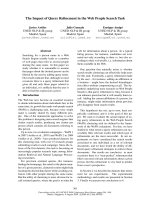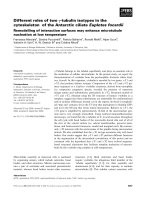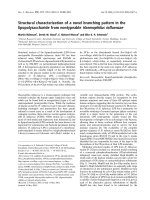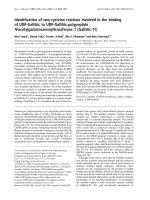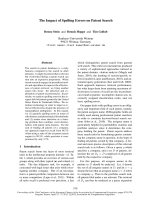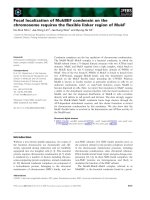báo cáo khoa học: " The production of consumption: addressing the impact of mineral mining on tuberculosis in southern Africa" pdf
Bạn đang xem bản rút gọn của tài liệu. Xem và tải ngay bản đầy đủ của tài liệu tại đây (263.38 KB, 8 trang )
BioMed Central
Page 1 of 8
(page number not for citation purposes)
Globalization and Health
Open Access
Debate
The production of consumption: addressing the impact of mineral
mining on tuberculosis in southern Africa
Sanjay Basu*
1,2
, David Stuckler
3
, Gregg Gonsalves
4
and Mark Lurie
5
Address:
1
Department of Medicine, University of California San Francisco, CA, USA,
2
Division of General Internal Medicine, San Francisco General
Hospital, CA, USA,
3
University of Oxford, Department of Sociology, Oxford, Oxfordshire, UK,
4
Department of Ecology and Evolutionary Biology,
Yale University, New Haven, CT, USA and
5
Department of Community Health, Brown University Medical School, Providence, RI, USA
Email: Sanjay Basu* - ; David Stuckler - ; Gregg Gonsalves - ;
Mark Lurie -
* Corresponding author
Abstract
Background: Miners in southern Africa experience incident rates of tuberculosis up to ten times
greater than the general population. Migration to and from mines may be amplifying tuberculosis
epidemics in the general population.
Discussion: Migration to and from mineral mines contributes to HIV risks and associated
tuberculosis incidence. Health and safety conditions within mines also promote the risk of silicosis
(a tuberculosis risk factor) and transmission of tuberculosis bacilli in close quarters. In the context
of migration, current tuberculosis prevention and treatment strategies often fail to provide
sufficient continuity of care to ensure appropriate tuberculosis detection and treatment. Reports
from Lesotho and South Africa suggest that miners pose transmission risks to other household or
community members as they travel home undetected or inadequately treated, particularly with
drug-resistant forms of tuberculosis. Reducing risky exposures on the mines, enhancing the
continuity of primary care services, and improving the enforcement of occupational health codes
may mitigate the harmful association between mineral mining activities and tuberculosis incidence
among affected communities.
Summary: Tuberculosis incidence appears to be amplified by mineral mining operations in
southern Africa. A number of immediately-available measures to improve continuity of care for
miners, change recruitment and compensation practices, and reduce the primary risk of infection
may critically mitigate the negative association between mineral mining and tuberculosis.
Background
Miners in southern Africa have the highest tuberculosis
incidence of any working population. Rates of TB are, to
our knowledge, the greatest reported in the world: at least
three times higher than in any country [1]. The effects of
migration to and from the mines, the health and safety
conditions within the mines, and the limitations to cur-
rent tuberculosis prevention and treatment strategies
offered to miners all contribute to the present tuberculosis
burden among this population. The problem has recently
been amplified by concerns about the emergence of drug
resistant tuberculosis in southern Africa and the increas-
ing frequency of travel between mines and rural commu-
nities. This article examines the relationships between
Published: 29 September 2009
Globalization and Health 2009, 5:11 doi:10.1186/1744-8603-5-11
Received: 23 June 2009
Accepted: 29 September 2009
This article is available from: />© 2009 Basu et al; licensee BioMed Central Ltd.
This is an Open Access article distributed under the terms of the Creative Commons Attribution License ( />),
which permits unrestricted use, distribution, and reproduction in any medium, provided the original work is properly cited.
Globalization and Health 2009, 5:11 />Page 2 of 8
(page number not for citation purposes)
mining and tuberculosis in southern Africa and describes
current intervention options.
Discussion
Why are miners in southern Africa at high risk of
tuberculosis?
The mining industry is among southern Africa's largest
employers, particularly in the Republic of South Africa,
where one of every ten employed men (at least 500,000
men) mines for gold, diamonds or other minerals [2,3].
The South African government reports the incidence of
tuberculosis to be as high as 7,000 cases per 100,000 min-
ers, about ten times higher than among the general popu-
lation [4]. Very high rates of over 1,000 per 100,000 have
been reported among miners in other southern African
countries [5]. Miners have 3.6-fold greater odds of dying
from tuberculosis than other workers in the region [6].
These risks of tuberculosis have evolved over the past cen-
tury; at least as far back as 1903, mining was recognized as
a risk factor for TB incidence and mortality [7]. A combi-
nation of environmental and occupational explanations
have been proposed to explain the elevated risk of mor-
bidity and mortality from tuberculosis among miners.
Silica exposure
Exposure to silica dust increases the risk of pulmonary
tuberculosis, particularly among gold miners who drill
through hard rock. Miners with the scarring lesions char-
acteristic of silicosis about 18% to 31% of goldminers in
Botswana and South Africa have about a three-fold
increased risk of pulmonary tuberculosis compared with
those without silicosis [8]. In a recent study of nearly 700
South African goldminers, 24% had silicosis; of the min-
ers with silicosis, 44% had a history of tuberculosis, as
compared to 26% among those without silicosis [8].
Occupational conditions
Living and working conditions are also a cause for con-
cern. Mine shafts themselves are crowded and poorly-ven-
tilated, but so are hostels where over a dozen men can
share a small room [9]. These conditions are highly con-
ducive to infection; the rate of recurrent tuberculosis in a
recent South African prospective cohort of 600 miners was
about 8 per 100 person-years (as opposed to half of that
rate or less in the general population, [1]), with 69% of
recurrent cases attributable to reinfection rather than
relapse [10].
Migration and HIV
But occupational and environmental risks on mines apply
to the mining sector in wealthy countries, just as in poor
ones. What makes mining in southern Africa so dangerous
that tuberculosis rates are far higher among African min-
ers than in miners in the UK? While regulations are
weaker in southern Africa, the companies owning the
mines and determining typical occupational conditions
are multi-national corporations. The problem is not sim-
ply one of differential occupational hazards, but of the
social context for transmission and the interaction
between miners and the rest of the population.
An extensive migration system throughout southern
Africa was constructed over a century ago to facilitate the
movement of workers to mines. The system, which until
the early 1990's prohibited black workers from settling
permanently in "whites-only" areas, created patterns of
circular migration conducive to the spread of tuberculosis
both on the mines and to rural areas from which men
migrated [11]. Shantytowns developed around hostels,
with alcoholism and prostitution proliferating around
many. This corresponded to the spread of sexually-trans-
mitted diseases [12,13].
HIV has rapidly spread among miners and their partners
since the 1980's. The dramatic rise in HIV prevalence
among miners (upwards of 30% in some cohorts) has
been attributed in part to a subsequent increase in tuber-
culosis incidence among them [14]. According to one
industry study, nearly one-third of new mineworkers
without HIV will become infected within the first eighteen
months of employment [15]. HIV increases the likelihood
that a person infected with tuberculosis will progress to
active disease, shortens survival times among co-infected
individuals, and increases the likelihood of atypical tuber-
culosis manifestations that can be difficult to diagnose
[16]. HIV-tuberculosis co-infection is particularly prob-
lematic for miners: HIV and silicosis multiplicatively
increase the risk of tuberculosis, and tuberculosis inci-
dence among HIV-positive silicotic miners is about 15
times higher than among HIV-negative miners without
silicosis [17]. Migrants moving between their homes and
the mines usually do not have continuous access to treat-
ment, risking individual poor patient outcomes as well as
the development and subsequent transmission of drug-
resistant forms of disease.
Public health consequences
Changing migration patterns
Since the relaxation of rules restricting movement under
apartheid, miners are able to travel more frequently
between mines and their home communities. In South
Africa today, roughly 230,000 men migrate each year
from other countries for mining jobs [18]. Over 50,000
men travel to South African mines from Lesotho, and 60%
of them return home at least once per month; these indi-
viduals would normally travel home only once or twice
per year in prior decades [19]. The circular migration pat-
tern not only exposes people in low prevalence areas to
migrants with a higher prevalence of HIV and tuberculo-
sis, but also prevents continuity of care, adherence sup-
Globalization and Health 2009, 5:11 />Page 3 of 8
(page number not for citation purposes)
port, and consistent access to diagnostic facilities for
migrating miners.
Rising drug-resistance
In a cross-sectional study of over 28,000 South African
goldminers, 18% of 425 tuberculosis cases acquired
multi-drug resistance, and a further 9% had already-resist-
ant tuberculosis strains transmitted to them (primary
resistance). Over 13% of cases had previously failed ther-
apy [20]. Since August 2007, one-quarter of new multi-
drug and extensively drug resistant tuberculosis cases in
Lesotho were among miners or former miners [19].
Transmission to communities
Reports from communities affected by extensively drug-
resistant tuberculosis suggest that miners pose transmis-
sion risks to other household or community members as
they travel home undetected or inadequately treated [21].
The wave of new tuberculosis infections related to HIV is
also being accompanied by significant secondary trans-
mission of tuberculosis to HIV-uninfected persons [22].
Indeed, the number of mines in a population correlate
strongly to the overall population's tuberculosis incidence
(Fig. 1); while this suggests correlation and not causation,
the finding indicates that the implications of mining for
community-wide tuberculosis control requires further
investigation.
What is currently being done?
The mining industry has publicized its extensive system of
tertiary care facilities, including over three dozen hospitals
operated by several thousand healthcare staff. Miners typ-
The relationship of tuberculosis in the general population to the number of mines in the population among southern African nations (r = 0.41, p < 0.01)Figure 1
The relationship of tuberculosis in the general population to the number of mines in the population among
southern African nations (r = 0.41, p < 0.01).
Globalization and Health 2009, 5:11 />Page 4 of 8
(page number not for citation purposes)
ically receive annual physical examinations and X-rays to
detect active tuberculosis, with laboratory confirmation of
tuberculosis diagnosis. The industry also boasts full com-
pliance with the World Health Organization directly-
observed tuberculosis treatment, a silicosis prevention
program involving dust control measures, and an antiret-
roviral treatment program [23].
But the mining industry is not required to report publicly
its data on disease incidence and outcomes, and, in South
Africa, the industry reports to a government agency that
keeps its results secret. Some of the publicly-available
information released by the mining industry about their
medical operations appears to conflict with independent
assessments and descriptive studies of miners' lives.
Appendix 1 describes evidence revealing that (i) screening
rates reported by mining companies are out of sync with
autopsy data which reveal high rates of undetected active
tuberculosis among miners, (ii) contract miners are
excluded from care, and workers may be dismissed from
work without follow-up treatment when showing symp-
toms of tuberculosis, and (iii) significant gaps in continu-
ity of care and support for adherence to treatment exist in
spite of extensive tertiary care facilities at some large
mines. Although a review tool has become available for
the mining sector to assess TB program performance
(sponsored by the Department of Minerals and Energy in
2007), it has yet to be applied [24].
What can be done?
At least three sets of interventions can be implemented to
decrease tuberculosis incidence on the mines and con-
nected communities.
Reducing risk
First, we must reduce the risk of tuberculosis among min-
ers. The biological risks to miners in Africa should be no
higher than the risks faced by miners in western countries.
As the mining industry profits from a period of boom in
mineral demand (in part due to gold demand and rising
gold prices [2]), it has the capital that other industries are
current lacking. Building hostel environments that reduce
crowding and are designed with infection control in mind
may mitigate transmission rates among workers. In an
unprecedented step, one mining CEO abolished common
residences and launched a housing scheme whereby min-
ers could live with families. According to Deloitte, this led
to the mining group experiencing one of the lowest HIV/
AIDS growth rates in the industry, with clear benefits for
reducing TB risk[15]
Silicosis can be addressed through improved enforcement
of dust control regulations, yet most initiatives appear to
be industry-determined, based on suggested guidelines,
and ineffective. Indeed, the industry target for aggregate
dust measurements (0.1 mg/m3 of aggregate dust) is not
actually protective against silicosis [25]. Correcting this
target is essential to preventing silicosis, as are follow-up
screening and treatment services for former mineworkers,
because silicosis develops over 15-20 years which means
increased risk of TB could develop more than a decade
after miners have stopped working [8].
HIV prevention approaches are based on 'information-
dissemination', although there is no evidence that this
approach, or alternative peer-education and condom dis-
tribution programs, have led to changes in sexual behav-
ior among miners [26]. Structural interventions such as
expanding access to family housing, addressing alcohol-
ism, and ensuring appropriate viral suppression through
antiretroviral treatment appear to be insufficiently admin-
istered in the absence of external supervision of the min-
ing industry [27,28].
Expanding medical services
The mining industry must expand clinical services so that
access is not concentrated exclusively around larger
mines. Open access to data on case detection and out-
comes is necessary to evaluate the quality of care. Well-
coordinated tuberculosis detection and treatment pro-
grams have significantly lowered tuberculosis rates and
stabilized multi-drug resistance in some mining popula-
tions [29]. However, even programs that have achieved
and superseded conventional tuberculosis treatment tar-
gets (e.g., 85% of diagnosed subjects completing therapy)
have not interrupted epidemic rates of new tuberculosis
transmission among mineworkers [30]. Effectively treat-
ing cases of active tuberculosis will reduce incidence, but,
given the delay between symptom onset and tuberculosis
diagnosis, case detection and treatment alone may not be
adequate to reduce the infectious periods of patients [31].
Isoniazid preventive therapy, which significantly lowers
the likelihood that infected individuals will advance from
latent to active tuberculosis, could help reduce the risk of
infection [32]. Regardless of the implementation of pre-
ventive therapy, care must be provided without discrimi-
nation towards those with existing symptoms or prior
diagnoses of TB, and the government enforcement of
treatment standards is necessary to monitor mining
healthcare operations to ensure non-discrimination.
Addressing migration
Finally, many of the medical effects of migration can be
addressed through public health initiatives. At present,
miners have medical records available at their industry-
based sites of care, yet they sometimes also receive care at
their clinics at home. Case reports suggest that many min-
ers being treated for drug-resistant tuberculosis are
unknowingly treated with inappropriate drug regimens,
such as the use of drugs to which patients had likely pre-
Globalization and Health 2009, 5:11 />Page 5 of 8
(page number not for citation purposes)
viously developed resistance [19]. Allowing miners to
carry standardized paper-based medical records with
them on their trips home may make relevant treatment
history more accessible to physicians. The mining indus-
try coordinates an extensive recruiting system that finds
workers in distant regions. This system can also be
employed to provide the contact information of mining
medical facilities to health posts in rural home regions,
permitting the transfer of vital medical history when min-
ers seek care.
The South African Development Community (SADC)
trading group promotes cross-border employment
throughout the southern African region; in turn, it bears
some responsibility and possesses the regional authority
to address the medical information challenges posed by
cross-border TB management, including discrepancies in
treatment regimens and the need for coherent and effec-
tive referral services for miners.
Coordination and Leadership
Overall, there is a critical absence of a focal point of gov-
ernment leadership and a clear delineation of responsibil-
ities between different institutions. Several government
ministries are involved in the management of TB in min-
ing, including the Department of Minerals and Energy,
the Department of Health, the Department of Labour.
This results in dispersed responsibility and accountability
for managing TB risks, and often means that progress in
implementing effective risk reduction initiatives is slow
and uneven. Given the clear demonstrated health impact
of the mining sector on TB, and given that TB has been
declared a public health emergency in the region, there is
a strong case for the Department of Health in South
Africa, and other health departments in the region, to
assume a clear leadership role on this issue.
Challenges to implementation
Implementing these reforms will be met by considerable
challenges. The mining industry currently lacks incentives
to enhance tuberculosis prevention and treatment
approaches, as the limited public information it dissemi-
nates suggests high-quality treatment facilities and exten-
sive systems of care.
Yet, it is clear that the mining industry is not paying the
full price of enhanced tuberculosis risk among its workers.
Compensation for occupational disease remains difficult
for miners' families to obtain, typically including only
work shifts lost due to hospitalization, and requiring evi-
dence of second degree tuberculosis or permanent lung
damage (usually by demanding that families provide
organ samples to a government bureau for investigation).
Families typically report no compensation or delayed
compensation, which contributes to poverty after the loss
of the household breadwinner [19]. A 2005 report by
DeLoitte suggested that the compensation fund used by
mining companies is essentially bankrupt, and would
require the industry to increase funding by 100-fold to ful-
fill miners' claims. The high financial cost of addressing
TB is likely a key reason for the mining sector's reluctance
to act decisively[15]
The South African parliament's recent passage of the
Mines Health and Safety Amendment Bill imposes stricter
penalties on mining companies that do not comply with
required standards of health and safety. The law holds
employers criminally liable for the loss of life, injury or ill-
health that occurs as a result of neglect to take "all reason-
able steps" to create a safe and healthy working environ-
ment [33]. Support from the public health community is
needed to investigate independently the epidemiological
claims of the mining industry and monitor miners' treat-
ment, outcomes and compensation under this new legal
system.
Enforcement of improved labor conditions and medical
standards requires the active participation of miners'
unions. Traditionally, mining unions have focused on
occupational hazards in the form of accidents and trauma.
While it is appropriate to have serious concerns about
mining accidents, such accidents resulted in 199 deaths in
2006, TB, HIV and silicosis claimed at least 5,000 miners'
lives that year [1,34]. Particularly after the end of apart-
heid in South Africa and the development of stronger
unions in Botswana, unions have an opportunity to push
government regulators into the enforcement of improved
working standards. The unions must also address the issue
of undocumented workers, who have been traditionally
excluded from participation, but in recent years been
growing as a proportion of mineworkers. These groups
often have less job security and lower rates of access to
compensation, as well as lack formal representation.
Government cooperation will be vital to address cross-
border issues, particularly for cases of tuberculosis that are
sent home without care, and new tuberculosis infections
among family members; this requires that representatives
recognize the health burdens of mining are falling on
their constituents. A body of key stakeholders miners'
unions, medical providers, and government representa-
tives should assemble to determine how to enforce high
standards of follow-up care and compensation, such that
the burden of tuberculosis does not continue to be placed
on labor-supplying communities., Government leader-
ship and a clear delineation of responsibilities among
government responsibilities is needed to move forward.
In South Africa, various departments, ranging from the
Minerals and Energy Department to the Department of
Labour, could be directly or indirectly responsible for var-
Globalization and Health 2009, 5:11 />Page 6 of 8
(page number not for citation purposes)
ious components of the response to TB among miners.
But the clear health impact of mining on TB, and the
emergency-level of TB in the region, indicate that the
Department of Health must be principal in taking a lead-
ership role on this issue. Table 1 summarizes key areas for
investigation and intervention.
Conclusion
Mining continues vigorously in southern Africa, with
companies from Australia, India, Russia, and the United
Kingdom opening new mines throughout the region
under the framework of recent foreign trading agreements
[34]. As both the industry and its associated epidemics
resurge in the region, the time is ripe for mining officials
and public health practitioners to combat the avoidable
risk of disease connected with mining. This region is not
"resource-poor" but "resource-denied"; it is indeed ironic
that the area's abundance of mineral resources has
brought so much violence and disease. Mitigating the
public health costs of mining is logistically complex, but
potentially feasible with concerted effort. To engage the
mining-tuberculosis relationship is a matter of health
equity, as the fruits of mining have historically not been
shared with those who occupy and mine the land, while
the ill effects of mining have been disproportionately
placed upon the poorest of communities.
Summary
The effects of migration to and from mineral mines,
health and safety conditions within mines, and limita-
tions to current tuberculosis prevention and treatment
strategies offered to miners all contribute to a high tuber-
culosis burden among this group of workers.
The circular migration of miners to and from their home
communities poses the risk of increased tuberculosis
exposure among home community members. Migration
also prevents continuity of care, adherence support, and
consistent access to diagnostic facilities among migrants.
Reducing risky exposures on the mines, enhancing the
continuity of primary care services, and improving the
enforcement of occupational health codes may mitigate
the harmful association between mineral mining activities
and tuberculosis incidence among affected communities.
Abbreviations
TB: tuberculosis; HIV: human immunodeficiency virus.
Competing interests
The authors declare that they have no competing interests.
Table 1: Recommendations for strengthening tuberculosis control strategies for miners and their communities
Dimension Issue Recommendation
Healthcare
Primary Care -Mines provide tertiary care for accidents and injuries but weak
primary care
-Monitor adherence to treatment guidelines among
medical providers
-Evaluate and improve standards of living and safety on
mines
-Evaluate and implement isoniazid preventive therapy
Continuity of Care -Mineworkers cross borders but care does not -Provide a standardized set of patient-held medical
records, and coordinate key care locations across borders
-Doctors lack patient information needed to avoid breeding
drug-resistant TB strains
-Key stakeholders, including mineworkers'
representatives, should create a formal body to investigate
and evaluate both within-country and cross-border TB
management among migrants
Recruitment -Contracts with loopholes -Provide clear translation and communication of contract
implications to workers, with union supervision
-Poor literacy -Include health benefits and protections for contract
employees
-Allow and encourage family housing and rights to
permanent residence
-Enforce and produce new laws for occupational safety
Compensation -Former and informal barriers prevent mineworkers and their
families from receiving compensation at all, or in a timely manner
-Avoid unnecessary restrictions and obstacles to qualify
for compensation and receive it promptly
-Create bodies of oversight to examine compensation
system
Globalization and Health 2009, 5:11 />Page 7 of 8
(page number not for citation purposes)
Authors' contributions
SB drafted the manuscript; DS, GG and ML provided data
and assisted in revision of the manuscript.
Appendix 1. Conflicts between Mining Company
Reports and Independent Assessments
1) Medical programs are limited to larger mining houses
and men who are currently employed. As increasing num-
bers of workers serve as contract employees, supplied by
intermediary companies or otherwise not included in
standard benefit scales, their entitlements to health bene-
fits is limited [19].
2) In spite of mining company reports of annual or more
frequent tuberculosis screening [23], a post-mortem study
suggests that 40% of tuberculosis cases among miners are
undetected during life [35].
3) Confirmation of appropriate treatment adherence also
indicates that adherence to treatment is only 85% (rather
than the reported 99.8%) among the 40% of patients who
returned urine samples in a recent assessment. Thirty-five
percent of patients' urine samples also contained tubercu-
losis drugs not recorded in their medical records [36].
4) In previous years, miners with tuberculosis were sent
home without care, as mining companies avoided the
costs of treating infected workers. While this practice is
technically now illegal, recent case reports particularly
among foreign migrant workers infected with multi-drug
or extensively drug resistant tuberculosis suggest that the
practice continues, producing a burden and risk for both
miners and their labor-supplying communities [37].
5) Patients are treated through a hospital-based system,
yet the extensive tertiary care facilities available on some
mines lack an effectively-coordinated primary care back-
bone for treatment initiation and support [26]. Because
this problem extends to HIV care as well, many miners
have been found with advanced, untreated HIV disease,
which misses the opportunity to decrease tuberculosis
incidence through effective antiretroviral therapy [19,38].
References
1. World Health Organization: Global tuberculosis control - sur-
veillance, planning, financing. WHO; 2008.
2. South African Chamber of Mines: Facts and Figures 2007. Johan-
nesburg: Chamber of Mines.
3. Tshitereke C: GEAR and Labour in Post-Apartheid South
Africa: A Study of the GoldMining Industry, 1987-2004.
Queen's University Ph.D. Thesis; 2004.
4. Government of South Africa: Tuberculosis Strategic Plan for
South Africa, 2007-2011. Durban: Ministry of Health; 2007.
5. Feierman S, Janzen JM, Studies JCoA: The Social Basis of Health and
Healing in Africa 1992.
6. Reid PJ, Sluis-Cremer GK: Mortality of white South African gold
miners. Occup Environ Med 1996, 53(1):11-16.
7. Marks S, Trapido S: Lord Milner and the South African State.
History Workshop 1979, 8:50-80.
8. Girdler-Brown BV, White NW, Ehrlich RI, Churchyard GJ: The bur-
den of silicosis, pulmonary tuberculosis and COPD among
former Basotho goldminers. American Journal of Industrial Medi-
cine 2008, 51(9):640-647.
9. Leon R, Davies A, Salomon M, Davies J: Leon Commission of Enquiry into
safety and health in the mining industry Pretoria: Government Printers;
1995.
10. Charalambous S, Grant AD, Moloi V, Warren R, Day JH, van Helden
P, Hayes RJ, Fielding KL, De Cock KM, Chaisson RE, et al.: Contribu-
tion of reinfection to recurrent tuberculosis in South African
gold miners. The International Journal of Tuberculosis and Lung Dis-
ease: The Official Journal of the International Union Against Tuberculosis
and Lung Disease 2008, 12(8):942-948.
11. Packard R: White Plague, black labor: tuberculosis and the political econo-
myof health and disease in South Africa Berkeley: University of California
Press; 1987.
12. Kark SL: The social pathology of syphilis in Africans. 1949. Int
J Epidemiol 2003, 32(2):181-186.
13. Lurie MN, Williams BG, Zuma K, Mkaya-Mwamburi D, Garnett G,
Sturm AW, Sweat MD, Gittelsohn J, Abdool Karim SS: The impact
of migration on HIV-1 transmission in South Africa: a study
of migrant and nonmigrant men and their partners. Sexually
Transmitted Diseases 2003, 30(2):149-156.
14. Churchyard GJ, Kleinschmidt I, Corbett EL, Mulder D, De Cock KM:
Mycobacterial disease in South African gold miners in the
era of HIV infection. The International Journal of Tuberculosis and
Lung Disease: The Official Journal of the International Union Against Tuber-
culosis and Lung Disease 1999, 3(9):
791-798.
15. DeLoitte: Deloitte on Mining & Metals: Taking the gamble out of mining
related risk: Deloitte 2006.
16. Havlir DV, Barnes PF: Tuberculosis in patients with human
immunodeficiency virus infection. N Engl J Med 1999,
340(5):367-373.
17. Corbett EL, Churchyard GJ, Clayton TC, Williams BG, Mulder D,
Hayes RJ, De Cock KM: HIV infection and silicosis: the impact
of two potent risk factors on the incidence of mycobacterial
disease in South African miners. Aids 2000, 14(17):2759-2768.
18. Crush J, Dodson B: Another lost decade: the failures of South
Africa's post-apartheid migration policy. Tijdschrift voor Econo-
mische en Sociale Geografi 98(4):436-454.
19. Aids and Rights Alliance: The Mining Sector, Tuberculosis and
Migrant Labour in Southern Africa. Durban: ARASA; 2008.
20. Murray J, Sonnenberg P, Shearer S, Godfrey-Faussett P: Drug-resist-
ant pulmonary tuberculosis in a cohort of southern African
goldminers with a high prevalence of HIV infection. S Afr Med
J 2000, 90(4):381-386.
21. Agence France Presse: Six South African miners isolated as TB
scare grows. 2006.
22. Sonnenberg P, Glynn JR, Fielding K, Murray J, Godfrey-Faussett P,
Shearer S: HIV and pulmonary tuberculosis: the impact goes
beyond those infected with HIV. AIDS 2004, 18(4):657-662.
23. Report to society 2003 [ />webs/InformationForInvestors/ReportToSociety03/
occ_health_review.htm]
24. Akugizibwe P: South Africa: A Century of Deafness to Facts
About Lung Disease in Miners. Business Day 2009.
25. Nelson G: Silicosis in South African miners: an autopsy study.
National Institute for Occupational Health South Africa; 2008.
26. Williams B, Campbell C, Mqoqi N, Kleinschmidt I: Occupational
health, occupational illness: tuberculosis, silicosis and HIV on
the South African Mines. In Occupational Lung Disease: An Interna-
tional Perspective Chapman & Hall; 1998.
27. Gebrekristos HT, Resch SC, Zuma K, Lurie MN: Estimating the
impact of establishing family housing on the annual risk of
HIV infection in South African mining communities. Sexually
Transmitted Diseases 2005, 32(6):333-340.
28. Blankenship KM, Friedman SR, Dworkin S, Mantell JE: Structural
interventions: concepts, challenges and opportunities for
research. Journal of Urban Health: Bulletin of the New York Academy of
Medicine 2006, 83(1):59-72.
29. Churchyard GJ, Corbett EL, Kleinschmidt I, Mulder D, De Cock KM:
Drug-resistant tuberculosis in South African gold miners:
incidence and associated factors. Int J Tuberc Lung Dis 2000,
4(5):433-440.
30. Godfrey-Faussett P, Sonnenberg P, Shearer SC, Bruce MC, Mee C,
Morris L, Murray J: Tuberculosis control and molecular epide-
Publish with Bio Med Central and every
scientist can read your work free of charge
"BioMed Central will be the most significant development for
disseminating the results of biomedical research in our lifetime."
Sir Paul Nurse, Cancer Research UK
Your research papers will be:
available free of charge to the entire biomedical community
peer reviewed and published immediately upon acceptance
cited in PubMed and archived on PubMed Central
yours — you keep the copyright
Submit your manuscript here:
/>BioMedcentral
Globalization and Health 2009, 5:11 />Page 8 of 8
(page number not for citation purposes)
miology in a South African gold-mining community. Lancet
2000, 356(9235):1066-1071.
31. Corbett EL, Bandason T, Cheung YB, Munyati S, Godfrey-Faussett P,
Hayes R, Churchyard G, Butterworth A, Mason P: Epidemiology of
tuberculosis in a high HIV prevalence population provided
with enhanced diagnosis of symptomatic disease. PLoS Med
2007, 4(1):e22-e22.
32. Churchyard GJ, Scano F, Grant AD, Chaisson RE: Tuberculosis pre-
ventive therapy in the era of HIV infection: overview and
research priorities. J Infect Dis 2007, 196(Suppl 1):. S52-62-S52-
62
33. Government of South A: Mines Health and Safety Amendment
Bill. Republic of South Africa: Department of Minerals and Energy;
2008.
34. South African Department of Minerals and Energy: Mining and minerals
in South Africa: Brand South Africa 2008.
35. Lowe R, Murray J: Tuberculosis at autopsy in Black Mine Work-
ers. National Center for Occupational Health; 1994.
36. Mqoqi NP, Churchyard GA, Kleinschmidt I, Williams B: Attendance
versus compliance with tuberculosis treatment in an occupa-
tional setting a pilot study. S Afr Med J 1997, 87(11):1517-1521.
37. Smart T: Migrants with MDR-TB in southern Africa being
dumped off at borders without referrals to care. AIDSMap
2008.
38. Williams BG, Dye C: Antiretroviral drugs for tuberculosis con-
trol in the era of HIV/AIDS. Science 2003, 301(5639):1535-1537.

